IMPORTANT TERMS
- Work plays an important role in our lives, as individuals and as members of society.
- Every rational man aims to be engaged in certain work to earn a living.
- Some work on farms, in factories, banks, and shops and a few others work at home.
- Work at Home includes not only traditional work like weaving, lace making, or a variety of handicrafts but also modern jobs like programming work in the IT industry.
- Earlier factory work meant working in factories located in cities, whereas, now technology has enabled people to produce those factory-based goods at home in villages.
Important Points about Work
- People work to 'earn' a living. Employment is an activity from which a person earns means of livelihood.
- Some people get money by inheriting it. However, it does not completely satisfy anybody. Being employed in work gives us a sense of self-worth and enables us to relate ourselves meaningfully with others.
- Every working person contributes to national income by engaging in various economic activities.
- We work not only for ourselves but also for those who depend on us as if our family gives us a sense of accomplishment when we work to meet their requirements.
- The study of working people gives us insights into the quality and nature of employment in our country and helps in understanding and planning our human resources.
- It helps in analyzing the contribution made by different industries and sectors toward national income.
- It also helps us to address many social issues such as exploitation of marginalized sections of society, child labor, etc.
Worker
Meaning: A worker is an individual, who is involved in some economic activity, to earn a living.
• A worker contributes to the process of gross domestic product (GDP) by rendering his productive activities.
• Some examples of workers are farmers, managers, laborers, doctors, barbers, professors, etc.
Gross Domestic Product and Gross National Product Gross Domestic Product (GDP): GDP refers to the total money value of all goods and services produced in a country in a year. Gross National Product (GNP): When net earnings** are added to GDP, we get GNP. Those activities which contribute to GNP are called economic activities. **Net Earnings: The difference between imports payments and exports receipts is termed net earnings for the country. Net Earnings can be • Positive when receipts from exports are more than payments for imports. • Zero, when receipts from exports are equal to payments for imports. 1. Negative, when receipts from exports are less than payments for imports.
Who all are included in ‘Workers'?
- It is generally believed that people who are paid by an employer are workers. However, this is not true.
- It also includes so includes self-employed persons, like shopkeepers, barbers, cobblers, etc.
- It also includes those people who remain temporarily absent from work due to illness, injury, or other physical disability, bad weather, festivals, social or religious functions, or some other reasons.
- It also includes those people who help the main workers. It means, that all those who are engaged in economic activities, in whatever capacity, are workers.
- in terms, workers include all those people, who are engaged in work, whether for others (paid workers) or for themselves (self-employed workers).
Nature of Employment in India is Multifaceted.
- Some get employment throughout the year, while others get employed for only a few months in a year, like seasonal workers.
- Many workers do not get fair wages for their work.
- While estimating the number of workers, all those who are engaged in economic activities are included as employed.
Number of Workers
- During 2011-12, the total number of workers in India was 473 million persons. Since the majority of our people reside in rural areas, the proportion of the workforce residing there is higher. Therefore, out of 473 million workers, nearly three-fourths were rural workers.
- Around 70% of total workers are male workers and the rest are female workers.
- Rural women participate in a larger number of productive activities as compared to urban women. Among the rural workers, the share of female workers is more than one-third, whereas the share is around one-fifth in the case of urban workers.
- In rural areas, many women carry out works like cooking, fetching water, fuelwood, and participating in farm labor. They are either not paid wages in cash or are paid in the form of grains. For this reason, these women are not categorized as workers. However, it is often argued that these women should also be called workers.
Labour Force
Meaning: All persons, who are working (have a job) and though not working, are seeking and are available for work, are deemed to be in the labor force.
Labour Force = Persons working + Persons seeking and/or available for work.
In other words, Labour Force is the total of employed and unemployed persons.
How to calculate labor force?
Subtract the following from the total population:
- Unfit People like old or handicapped persons;
- People who are not willing to work;
- People who are not available for work.
Labour Force Participation Rate (Or Work Force Participation Rate)
Meaning: The ratio of labor force to total population is called Labour Force Participation Rate. It is used for analyzing the situation of a country.
Work Force
The number of persons, who are actually employed at a particular time, is known as work force. It includes all those persons who are actually engaged in productive activities.
Calculation of Number of Unemployed People
With the help of labor force and workforce, we can calculate the number of unemployed people. If we subtract the workforce from the labor force, we get a number of unemployed people.
Unemployed People = Labour Force - Work Force
WORKER POPULATION RATIO
Worker Population Ratio
PARTICIPATION OF PEOPLE IN EMPLOYMENT
Meaning: "Worker-Population ratio" is an indicator, which is used to analyze the employment situation du the country. The worker-Population ratio is calculated by dividing the total number of workers in India by the population in India and multiplying it by 100.
Important Points about Worker-Population Ratio
- The worker-Population ratio is very useful in determining the proportion of the population contributing to the production of goods and services of a country.
- Higher ratio indicates that a high proportion of its population is involved in economic activities.
- Medium or lower ratio indicates that less people are involved in economic activities.
- The worker-population ratio indicates the status of workers in society and their working conditions.
- By knowing the status with which a worker is placed in an enterprise, it may be possible to determine the quality of employment in a country.
- It also enables us to know the attachment, which a worker has with his job and the authority possessed by him over the enterprise and over other co-workers.
Facts and figures about worker-population ratio:
- For every 100 persons, 38.6% are workers in India.
- Higher Proportion of Rural People: In urban areas, the proportion is 35.5%, whereas in rural India, the ratio is about 39.9%.
- Employment Opportunities: Rural people have limited resources and participate more in the employment market. On the other hand, urban people have a variety of employment opportunities. They look for the appropriate job to suit their qualifications and skills.
- Education Level: In rural areas, many do not go to schools or colleges and even if some go, they discontinue in the middle to join the workforce. In urban areas, a considerable section is able to study in various educational institutions.
- Higher Proportion of Male Workers: As compared to females (21.9%), more males (54.4%) are found to be working. Men are able to earn high incomes and, therefore, families discourage female members from taking up jobs.
- More Women Workers in rural areas: The ratio of women workers in rural areas (24.8%) is more than the number of women workers in urban areas (14.7%). It happens because people in rural areas cannot stay at home due to their poor economic conditions.
- Underestimation of Women Workers: The number of women workers in our country is generally underestimated because many activities undertaken by them are not recognized as productive work. For example, many women are actively engaged in activities within the house and at family farms, but are neither paid for such work, nor are counted as a worker.

EMPLOYMENT
Meaning of Employment
Meaning: Employment is an activity, which enables a person to earn means of living. It refers to an arrangement, by which a person earns income or means of livelihood. Employment can be in form of:
- Self-employment
- Wage employment.
Self-Employment
Meaning: An arrangement, in which a worker uses his own resources to make a living, is known as self-employment.
- Workers who own and operate an enterprise to earn their livelihood are known as self-employed.
- About 52% of workforce in India belongs to this category.
- Self-employment is a major source of livelihood for both men and women.
- In the case of self-employment, a person makes use of his own land, labor, capital and entrepreneurship, to make a living.
- For example, shopkeepers, traders, businesspersons, etc.
Wage Employment
Meaning: An arrangement in which a worker sells his labor and earns wages in return, is known as wage employment.
- Under wage employment, the worker is known as an employee (or hired worker) and the buyer of labor is termed as an employer.
- Workers do not have any other resources (land, capital and entrepreneurship), except their own labor.
- They offer their labor services to others and in return get wages.
- For example, a doctor running his own clinic is an example of self-employment. However, if the doctor is employed by a hospital, then it will be wage employment.
- Wage employment is of two types:
- Regular Workers;
- Casual Workers.
Regular Workers
Meaning: When a worker is engaged by someone or by an enterprise and is paid wages on a regular basis, then such a worker is known as a regular salaried employee.
- Workers are hired on a permanent basis and get social security benefits (like pension, provident fund, etc.).
- Regular workers account for just 18% of India's workforce.
- For example, Professors, Teachers, Civil engineers working in the construction company, etc.
Casual Workers
Meaning: Workers who are casually engaged and, in return, get remuneration for up work done, are termed as casual workers.
- Casual workers are not hired on a permanent basis. It means they do not have: (i) Regular income; (ii) Protection or regulation from the government; (iii) Job security; and (iv) Social benefits.
- Casual workers account for 30% of India's workforce.
Distribution of Employment
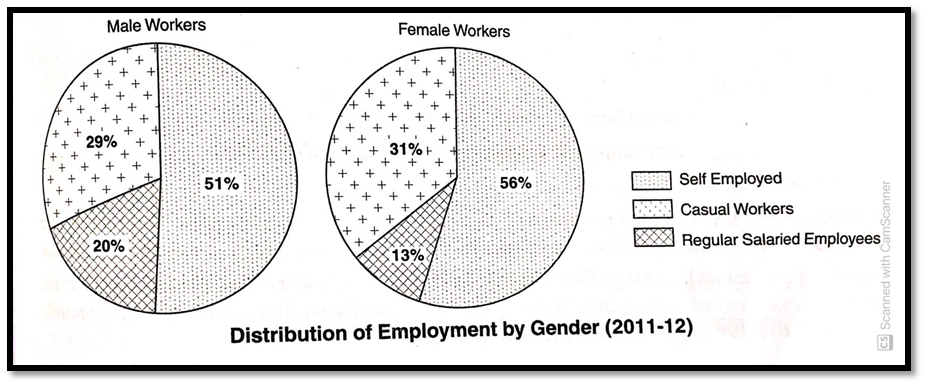
From the Pie diagrams, the following points are noticed:
- Self-employment is a major source of livelihood for both men (51%) and women (5601
- Casual workers account for the second major source for both men (29%) and women (310
- In the case of regular salaried employment, men are found in greater proportion (20%), whereas women form only 13%. The reason for this could be skill requirements as regular salaried jobs require skills and a higher level of literacy.
Distribution of Employment by Region.
- Self-Employment: It is a major source of livelihood in both urban areas (43%) and rural from (56%). However, in the case of rural areas, self-employed workers are greater as a majority of rural people are engaged in farming on their own plots of land.
- Casual Workers: In the case of rural areas, casual workers account for the second major source of employment with 35% of the workforce. Casual workers in urban areas account for 15%.
- Regular Salaried Employees: In urban areas, it is the second major source with 42% of work force. Urban people have a variety of employment opportunities because of their educational attainments and skills. In urban areas, the nature of work is different and enterprises require workers on a regular basis. However, only 9% of rural people are engaged as regular salaried employees due to illiteracy and lack of skills.
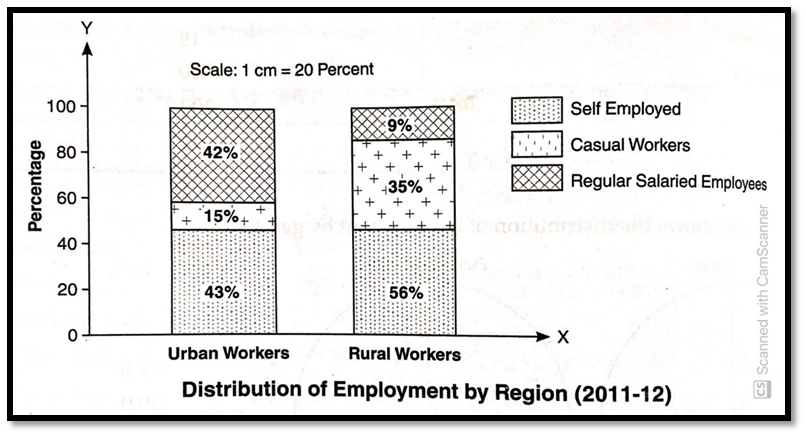
Distribution of Employment in Different sectors
In the course of the economic development of a country, labor flows from agriculture and other related activities to industry and services. In this process, workers migrate from rural to urban areas. Eventually, at a much later stage, the industrial sector begins to lose its share of total employment as the service sector enters a period of rapid expansion. Generally, we divide all economic activities into the following 8 different industrial divisions:
Distribution of Rural-Urban Employment in different sectors.
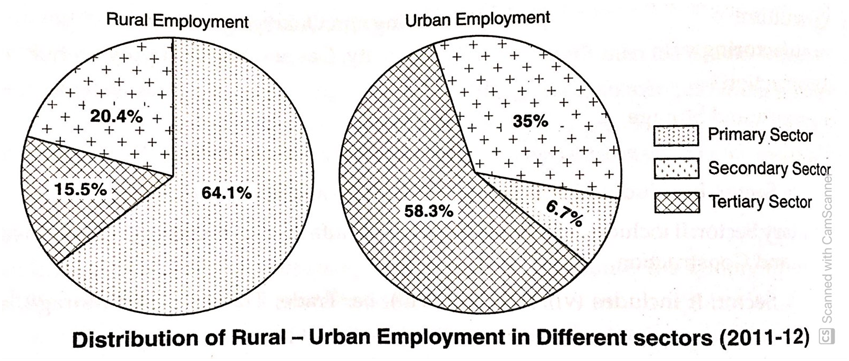
Employment in Rural Areas
- 64.1% of the workforce in rural areas are engaged in the primary sector. (Agriculture, mining, and quarrying).
- 20.4% of rural workers are working in the secondary sector. (Manufacturing industries, construction and other divisions).
- The service sector or Tertiary sector provides employment for 15.5% of rural workers.
Employment in Urban Areas
- In the case of urban areas, the primary sector has the least share with just 6.7%. Therefore, activities like agriculture or mining are not the major source of employment in urban areas.
- The secondary sector gives employment to about 35% of the urban workforce.
- People are mainly engaged in the service sector with 58.3% of urban workers.
Distribution of Employment (Male-Female) in Different sectors
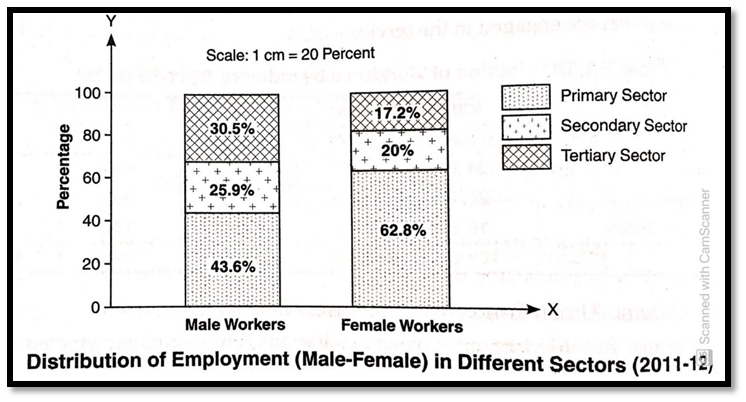
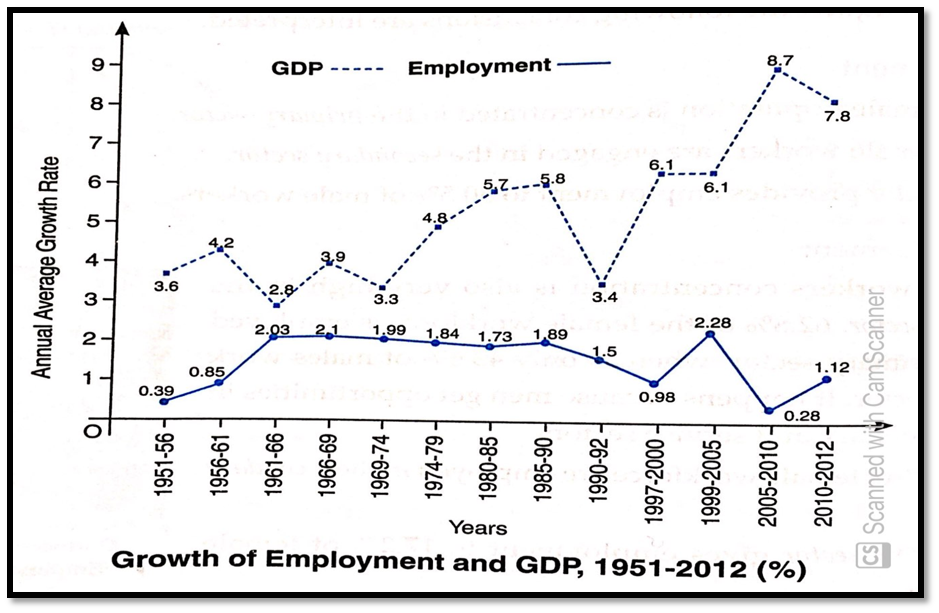
GROWTH & CHANGING STRUCTURE OF EMPLOYMENT
Changing Structure of Employment
- A major section of our population lives in rural areas and is dependent on agriculture as their main livelihood.
- The developmental strategies in many countries, including India, have always aimed at reducing the proportion of people depending on agriculture.
- Following is the effect on different sections of workforce, due to growth pattern of employment and GDP:

- In 1972-73, 74.3% of workforce was in 2011-12. It shows a substantial decline to 48.9% in 2011-12. It shows a substantial shift from farm work to non-farm work.
- Secondary and service sectors are showing promising, as shares of these sectors have increased from 10.9% to 24.37 respectively.
Casualization of Workforce
- Over the last three decades (1972-2012), there has been considerable. In addition, regular salaried employed to casual wage work.
- The process of moving from self-employment and regular salaried employment to casual wage work is known as casualization of workforce.

- Self-Employment: Although, it continues to be the major employment provider, its share declined from 61.4% in 1972-73 to 52% in 2011-12.
- Regular Salaried Employees: Its share has stagnated at around 14%. There is a marginal increase from 15.4% in 1972-73 to 18% in 2011-12.
- Casual Workers: Their share has increased from 23.2% in 1972-73 to 30% in 2011-12.
INFORMALISATION OF THE INDIAN WORKFORCE
- Even after 55 years of planned development, three-fifth of Indian depends on agriculture as the major source of livelihood.
- Over the years, the quality of employment has also deteriorated. Even others do not get maternity benefit, provident fund, gratuity more than 10-20 years, some workers do not get maternity benefit or and pension.
- Employees in the private sector get a lower salary as compared to employees doing the same work in the public sector.
- The employment structure in India can be studied with respect to two kinds of sectors. (I) Formal or Organised Sector; (ii) Informal or Unorganised Sector.
Formal or Organised Sector
- All the public enterprises and private establishments, employ 10 or more hired workers. are called formal sector establishments.
- Workers who work in such establishments are known as formal sector workers.
- Formal workers enjoy social security benefits and earn more than those in the informal sector earn.
- The government protects them in various ways through its labor laws and they can form 'Trade Unions' to protect their interests.
- However, the organized sector provides work to just 7% of the total work force.
Informal or Unorganised Sector
- Informal sector includes all those private enterprises, which hire less than 10 workers.
- Workers who work in such enterprises are known as informal sector workers. For example, farmers, agricultural laborers, owners of small enterprises, etc.
- It also includes all non-farm casual wage laborers who work for more than one employer such as construction workers and headload workers.
- In India, over 90% of employment is found in the unorganized sector, viz., small farms, household industries, shops and other self-employment units.
- In the informal sector, male workers account for 69% of the workforce.
- Workers and enterprises in the informal sector do not get regular income. They do not have any protection or regulation from the government. Such workers have the risk of being dismissed without any compensation.
- Workers of this sector live in slums and are squatters (persons who unlawfully occupy an uninhabited building or unused land).
- Informal sector uses outdated technology and does not maintain any accounts.
Distribution of Workforce in Formal and Informal Sectors
As the economy grows, more and more workers should become formal sector workers and the proportion of workers engaged in the informal sector should decrease.
Formal Vs Informal:
- Out of a total of 473 million workers in the country.
- 30 million workers are in the formal sector and the remaining 443 mills in the informal sector.
- It means, only 6% of people are employed in the formal sector and the rest in the informal sector.
Male Vs Female
- In the formal sector, out of 30 million workers, 24 million (80%) are male workers and only 6 million (20%) are women.
- In the informal sector, out of 443 million workers, male workers account for 306 million (69%) and the remaining 137 million (31%) are women.
Realizing the Importance of the Informal Sector
Due to the failure of the formal sector in generating employment, India started paying attention to enterprises and workers in the informal sector. With the efforts of the International Labour Organisation (ILO), the Indian government has initiated the modernization of informal sector enterprises and the provision of social security measures to informal sector workers.
UNEMPLOYMENT
Meaning of Unemployment
- According to NSSO, Unemployment is a situation in which all those who, owing to lack of work, are not working but either seek work through employment exchanges, intermediaries, friends, or relatives or by making applications to prospective employers or express their willingness or availability for work under the prevailing condition of work and remunerations.
- In short, Unemployment refers to a situation in which people are willing and able to work at the existing wage rate, but do not get work. Unemployment is confined not only to unskilled workers, rather a sizeable number of skilled workers fail to get jobs for long periods.
Unemployment is Temporary even in India
- In India, people cannot remain completely unemployed for very long because of their desperate economic condition. As a result, they are forced to accept unpleasant, dangerous jobs in unclean or unhealthy surroundings.
Sources of Unemployment Data
- Reports of Census of India: The population census collects information on the economic activity of people.
- National Sample Survey Organisation (NSSO): The NSSO collects data through sample surveys and gives annual estimates of employment and unemployment.
- Directorate General of Employment and Training (DGET) has been implementing the Employment Market Information (EMI) scheme over the last 30 years. EMI provides information about the structure of employment, occupational compositions and educational profile of employees.
- All three sources of data give different estimates of unemployment. However, they provide us with the attributes of the unemployed and the variety of unemployment prevailing in our country.
Types of Unemployment in India
- Disguised Unemployment (Hidden Unemployment).
Meaning: Disguised Unemployment refers to a state in which more people are engaged in work than are really needed.
- For example, if two workers are needed on a piece of land and five workers are engaged in the same job, then three workers are disguised as unemployed.
- It is the most predominant form of unemployment in the agricultural sector of developing countries like India.
- In the late 1950s, about one-third of agriculture workers in India were disguisedly unemployed.
- The main problem of disguised unemployment is that apparently, all seem to be employed, but marginal productivity of the surplus labor is zero, i.e. contribution of the extra workforce is zero. Disguised Unemployment is common in the case of sugarcane cutters.
- Seasonal Unemployment
Meaning: Unemployment that occurs at certain seasons of the year is known as seasonal unemployment.
- In India, seasonal unemployment is predominantly associated with agriculture.
- In agriculture, work is seasonal and there are no employment opportunities in the village for all months of the year. Therefore, when there is no work to do on farms, men go to urban areas and look for jobs. They come back to their home villages as soon as the rainy season begins.
- The period of seasonal unemployment varies from state to state, depending upon the methods of farming, the condition of soil, the type and number of crops grown, etc.
- Open Unemployment
Meaning: Open Unemployment refers to that economic phenomenon in which persons are able and to work at the prevailing wage rate, but fail to get work.
- It is called open unemployment such unemployment can be seen and counted in terms of the number of unemployed people.
- Open Unemployment is different from Disguised Unemployment. In the case of open Unemployment, workers are very idle. However, in the case of disguised unemployment, workers appear to be working and do not seem to be idling away their time.
Causes of Unemployment
- Slow Rate of Economic Growth: The actual growth rate always Population Explosion lies far below the rate targeted in the five decades of planning. Employment opportunities created under the plans could not keep pace with the additions to the labor force.
- Population Explosion: The rapid rate of population growth has been another cause of increasing unemployment in the country. It has not been possible to generate so many employment opportunities to absorb the large growing labor force.
- Underdeveloped Agriculture: Heavy pressure of population on land and the primitive methods of agricultural operations are responsible for massive rural unemployment and underemployment in the country.
- Defective Educational System: The prevailing education system in India is full of defects as it fails to make any provision for imparting technical and vocational education. As a result, educated people are unable to meet the requirements of the firm.
- Slow Growth of Industry: Due to a shortage of capital and lack of modern and advanced technology, the industrial sector could not gain momentum and could not generate sufficient employment opportunities in the country.
- The decline of Cottage and Small-scale Industries: The number of traditional villages and cottage industries has declined over the years due to changes in the demand preferences is the emergence of more efficient modern industries. As a result, a large number of people become unemployed.
- Faulty Planning: The plans could not stop the migration of the rural population to urban areas. The plans were unable to encourage the use of labor-intensive technic agricultural and industrial production. The plans have failed to put due emphasis on employment-generating programs like the development of dairies, fisheries and poultry farming. Insufficient infrastructure facilities (power, transportation, communication, etc.) have greatly hampered the expansion of work opportunities.
- Inadequate Employment Planning: Low priority has been given to employment objective plans. There has been a complete absence of any legal provision to implement employment-generating schemes.
- Low Capital Formation: Low rate of capital formation has hampered the growth potential in the agricultural and industrial sectors. Consequently, the job-creation capabilities of both sectors have been affected adversely.
Remedial Measures for Unemployment
- Accelerating growth rate of GDP: The aggregate employment problem can be solved through the process of accelerated growth. Growth rates of GDP between 8% and 9% are needed over the next ten years, to achieve a significant improvement in the employment situation.
- Control of population growth: The rapid growth rate of the population should be slowed down so that the additional jobs created do not fall short of new entrants to the labor market. Therefore, it is necessary to adopt an effective and meaningful population control policy, like family planning programs.
- Development of agricultural sector: Acceleration of agricultural growth is important to increase labor productivity and quality of employment for large numbers of the existing force. There is a need for an agricultural revolution through improved techniques, an extension of irrigation facilities, reform of land laws, an increase in public investment, etc.
- Encouragement to small-scale enterprises: The small-scale sector needs to be encouraged by multiple initiatives like liberal finance, technical training, and supply of raw materials, infrastructural facilities and marketing of their products.
- Improvements in Infrastructure: The infrastructural facilities like health, education, electricity, roads, etc. are critical for the overall development of the economy. Better cultural facilities enable the agriculture and industry sectors to produce to their full capacity. This will generate more employment.
- Special Employment Programs: Special employment programs, which aim at providing employment or self-employment opportunities, should be implemented.
- Improvement of Employment Exchanges: The employment exchanges spread all over the country are of great assistance in directing the job seekers to the possible areas of employment. The functioning of such employment exchanges should be improved
- Creation of self-employment opportunities: Government should provide various facilities like financial assistance, training of skills, supply of inputs, marketing of products, etc. to generate more self-employment opportunities.
- Reform of Educational System: The present system of the educational system should be ma vocational and work-oriented. Educational facilities should be more diversified and a sustained program of training is necessary, to develop skills among the educated unemployed through special training or apprenticeship courses.
- Labour Planning: The future requirements of educated labor should be forecasted and accordingly, intake into different professional courses should be determined. As a result, excess manpower in market of educated labor will be eliminated.
GOVERNMENT POLICIES & EMPLOYMENT GENERATION
GOVERNMENT POLICIES AND EMPLOYMENT GENERATION
- Government has taken many initiatives to generate acceptable employment, ensuring at least minimal safety and job satisfaction. Since independence, the Union and State Governments have played an important role in generating employment or creating opportunities for employment generation. Their efforts can be broadly categorized into two aspects:
- Government provides 'Direct Employment by employing people in various departments for administrative purposes. It also runs industries, hotels, and transport companies, and hence provides employment directly to workers.
- With increase in output of goods and services of government enterprises, private enterprises providing raw material to government enterprises will also raise their output. As a result, the number of employment opportunities in the economy will increase. This increase in employment is known as 'Indirect Employment by the government.
Employment Generation Programmes
- The government has also implemented a number of “Employment Generation Programmes” like the National Rural Employment Guarantee, Prime Minister's Rozgar Yojana, Swaran Jayanti Shahri Rozgar Yojana, etc.
- Government aims to alleviate poverty through such employment programs.
- All these programs aim at providing employment, services in primary health, education, rural shelter, etc.
- These programmes also aim to assist people in buying income and employment generating assets, developing community assets and construction of houses and sanitation.
CONCLUSION
Conclusion
- Service Sector – Emerging as a prospective employer: With the expansion of the service sector, newly emerging jobs are found mostly in this sector.
- Technological Advancement: Due to the advent of high technology, now efficient small-scale enterprises and individual enterprises work along with MNCs.
- Outsourcing of Work: Outsourcing involves contracting out an activity to an outside specialized agency (sometimes situated even in other countries), which undertakes complete responsibility to handle it using its own manpower. For example, many companies have started outsourcing sanitation and housekeeping functions, which were earlier performed by their in-house staff.
- Work at Home: Due to changes in work methods, it has now become a common practice for many people to work from their homes. The Internet has become an amazing means for work at home opportunities.
- More Employment in Informal Sector: The nature of employment has become more informal with only limited availability of social security measures to the workers.
- Growth in GDP, but not in employment opportunities: In the last two decades, there has been rapid growth in the gross domestic product (GDP), but without a simultaneous increase in employment opportunities. It has forced the government to take up initiatives in generating employment opportunities, particularly in the rural areas.

 PathSet Publications
PathSet Publications
